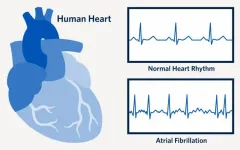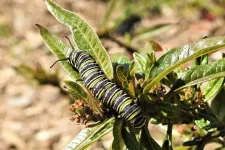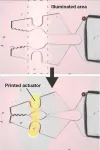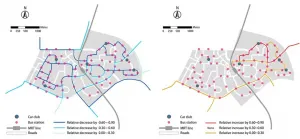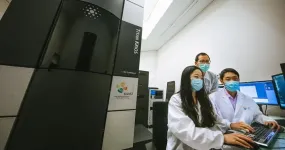HKUST scientists discover how antibiotics target bacterial RNAP to inhibit its gene transcription
2021-05-05
(Press-News.org) The emergence and spread of new forms of resistance remains a concern that urgently demand new antibiotics. Transcription is a vital process in bacterial cell, where genetic information in DNA is transcribed to RNA for the translation of proteins that perform cellular function. Hence, transcription serves as a promising target to develop new antibiotics because inhibition the transcription process should effectively kill the bacteria. Bacterial RNA Polymerase, the core enzyme for transcription, must load the DNA and separate the double-stranded DNA to single stranded DNA to read the genetic information to initiate transcription. This process is also called DNA melting and is facilitated by the opening and closing of the loading gate of RNA Polymerase. The loading gate contains two flexible pincers (clamp and β-lobe) resembling the shape of a crab claw. DNA melting via this loading gate is a multi-step and highly dynamic process, and it provides a promising strategy for the design of novel antibiotics by inhibiting this process. Yet, the understanding of DNA melting requires a detailed understanding in the movements and dynamics of the loading gate, the lack thereof hampers future development of antibiotics.
To offer new direction for more effective therapeutics, a research team led by Prof. Xuhui HUANG, Department of Chemistry and Department of Chemical and Biological Engineering at HKUST, recently discovered the working mechanism of an antibiotics, Myxopyronin, by targeting the movement of the loading gate to inhibit the DNA melting prior to bacterial gene transcription. The research team identified a partially closed form of the flexible clamp domain, into which an antibiotic called Myxopyronin can bind with. The binding of Myxopyronin to the RNA Polymerase diminishes the gate's ability to close, eventually inhibiting the DNA melting, which is vital for the survival of the bacteria.
More interestingly, the research team also found the unprecedented role of the β-lobe during the loading of DNA to the inner cleft of RNA Polymerase. They discovered that the opening of β-lobe is sufficient to accommodate the loading of double helix DNA without opening the Clamp. The role of β-lobe has not been previously reported, and this finding opens the opportunity to the development of new antibiotics targeting the β-lobe of RNA Polymerase to halt transcription.
"The shape of bacterial RNA polymerase resembles a crab claw that works like a pincer. The shape and flexibility of the two pincers are important for RNA Polymerase to hold and separate the double-helix form of DNA into single-stranded. We showed that an antibiotic that targets the movement of the pincers would be a promising as a drug candidate" said Prof. Huang. "What is more exciting, is that we also discovered a novel critical role of the β-lobe that can serve as a new target for future antibiotics development."
This work is made possible only with the quasi-Markov State Model (qMSM) recently developed in Prof. Huang's lab. qMSM is built from extensive all-atom molecular dynamics simulations, and successfully predicts dynamics of RNA Polymerase's loading gate at atomic resolution and millisecond (10-3 second) timescale. This new method adopts the generalized master equation formalism to encode non-Markovian dynamics, which has advantages over the popular Markov State Models based on Master Equation. Hence, it is especially promising to be applied to study complex conformational changes of proteins.
INFORMATION:
The first author of this work: Dr. Ilona UNARTAR is a long-time HKUST affiliate who completed her undergraduate, PhD, and currently conducts her post-doctoral training all at HKUST from Department of Chemistry and Bioengineering graduate program. Other collaborators of this work come from Kyoto University and King Abdullah University of Science and Technology.
[Attachments] See images for this press release:

ELSE PRESS RELEASES FROM THIS DATE:
2021-05-05
ORLANDO, May 5, 2021 - New research indicates that the legendary Sargasso Sea, which includes part of the Bermuda Triangle and has long featured in fiction as a place where ships go derelict, may actually be an important nursery habitat for young sea turtles.
In a study led by a University of Central Florida researcher and published today in the journal Proceedings of the Royal Society B, researchers presented evidence of baby green sea turtles arriving at the Sargasso Sea after entering the ocean off the east coast of Florida.
The study was the first time that green sea turtles have been tracked during their early "lost years," which is defined ...
2021-05-05
A UBC Okanagan researcher is urging people to learn and then heed the symptoms of Atrial Fibrillation (AF). Especially women.
Dr. Ryan Wilson, a post-doctoral fellow in the School of Nursing, says AF is the most commonly diagnosed arrhythmia (irregular heartbeat) in the world. Despite that, he says many people do not understand the pre-diagnosis symptoms and tend to ignore them. In fact, 77 per cent of the women in his most recent study had experienced symptoms for more than a year before receiving a diagnosis.
While working in a hospital emergency department (ED), Dr. Wilson noted that many patients came in with AF symptoms that included, but were not limited to, shortness of breath, feeling of butterflies (fluttering) in the chest, dizziness or general fatigue. Many women ...
2021-05-05
Seeing through smog and fog. Mapping out a person's blood vessels while monitoring heart rate at the same time--without touching the person's skin. Seeing through silicon wafers to inspect the quality and composition of electronic boards. These are just some of the capabilities of a new infrared imager developed by a team of researchers led by electrical engineers at the University of California San Diego.
The imager detects a part of the infrared spectrum called shortwave infrared light (wavelengths from 1000 to 1400 nanometers), which is right outside of the visible spectrum (400 to 700 nanometers). Shortwave infrared imaging is not to be confused with thermal imaging, which detects much longer infrared wavelengths ...
2021-05-05
A new Tel Aviv University study has revealed, for the first time, that bats know the speed of sound from birth. In order to prove this, the researchers raised bats from the time of their birth in a helium-enriched environment in which the speed of sound is higher than normal. They found that unlike humans, who map the world in units of distance, bats map the world in units of time. What this means is that the bat perceives an insect as being at a distance of nine milliseconds, and not one and a half meters, as was thought until now.
The Study was published in PNAS.
In order to determine ...
2021-05-05
PULLMAN, Wash. -- A count of the Western Monarch butterfly population last winter saw a staggering drop in numbers, but there are hopeful signs the beautiful pollinators are adapting to a changing climate and ecology.
The population, counted by citizen scientists at Monarch overwintering locations in southern California, dropped from around 300,000 three years ago to just 1,914 in 2020, leading to an increasing fear of extinction. However, last winter large populations of monarchs were found breeding in the San Francisco and Los Angeles areas. Prior to last winter, it was unusual to find winter breeding by monarchs ...
2021-05-05
The idea of deriving health benefits from live microorganisms is well known, but some non-living microorganisms, too, can have beneficial health effects. Yet even with an increasing number of scientific papers published on non-viable microbes for health, the category is not well defined and different terms are used in different contexts.
Now, a group of international experts has clarified this concept in a recently END ...
2021-05-05
A study published in Cretaceous Research expands the paleontological richness of continental fossils of the Lower Cretaceous with the discovery of a new water plant (charophytes), the species Mesochara dobrogeica. The study also identifies a new variety of carophytes from the Clavator genus (in particular, Clavator ampullaceus var. latibracteatus) and reveals a set of paleobiographical data from the Cretaceous much richer than other continental records such as dinosaurs'.
Among the authors of the study are Josep Sanjuan, Alba Vicente, Jordi Pérez-Cano and Carles Martín-Closas, members of the Faculty of Earth Sciences and the Biodiversity Research Institute (IRBio) of the University of Barcelona, in collaboration with the expert Marius Stoica, ...
2021-05-05
Ishikawa, Japan - Inside our cells, and those of the most well-known lifeforms, exist a variety of complex compounds known as "molecular motors." These biological machines are essential for various types of movement in living systems, from the microscopic rearrangement or transport of proteins within a single cell to the macroscopic contraction of muscle tissues. At the crossroads between robotics and nanotechnology, a goal that is highly sought after is finding ways to leverage the action of these tiny molecular motors to perform more sizeable tasks in a controllable manner. However, achieving this goal will certainly be challenging. "So far, even though researchers ...
2021-05-05
Singapore, 5 May 2021 - The rapid advancement of Autonomous Vehicles (AV) technology in recent years has changed transport systems and consumer habits globally. As countries worldwide see a surge in AV usage, the rise of shared Autonomous Mobility on Demand (AMoD) service is likely to be next on the cards. Public Transit (PT), a critical component of urban transportation, will inevitably be impacted by the upcoming influx of AMoD and the question remains unanswered on whether AMoD would co-exist with or threaten the PT system.
Researchers at the Future Urban Mobility (FM) Interdisciplinary Research Group (IRG) at Singapore-MIT Alliance for Research and Technology (SMART), MIT's research enterprise in Singapore, and Massachusetts ...
2021-05-05
The inner workings of a "self-destruct switch" present on human cells that can be activated during an immune response have been revealed. In unprecedented detail, KAUST scientists with collaborators in China report the 3D atomic structure of the human PANX1 protein, which may help underpin new therapies that target the immune system.
When cells become infected with a pathogen, the body's immune system works to destroy the infected cells before they become a threat to surrounding tissues. This form of cell death, during which a cell releases potent ...
LAST 30 PRESS RELEASES:
[Press-News.org] HKUST scientists discover how antibiotics target bacterial RNAP to inhibit its gene transcription


